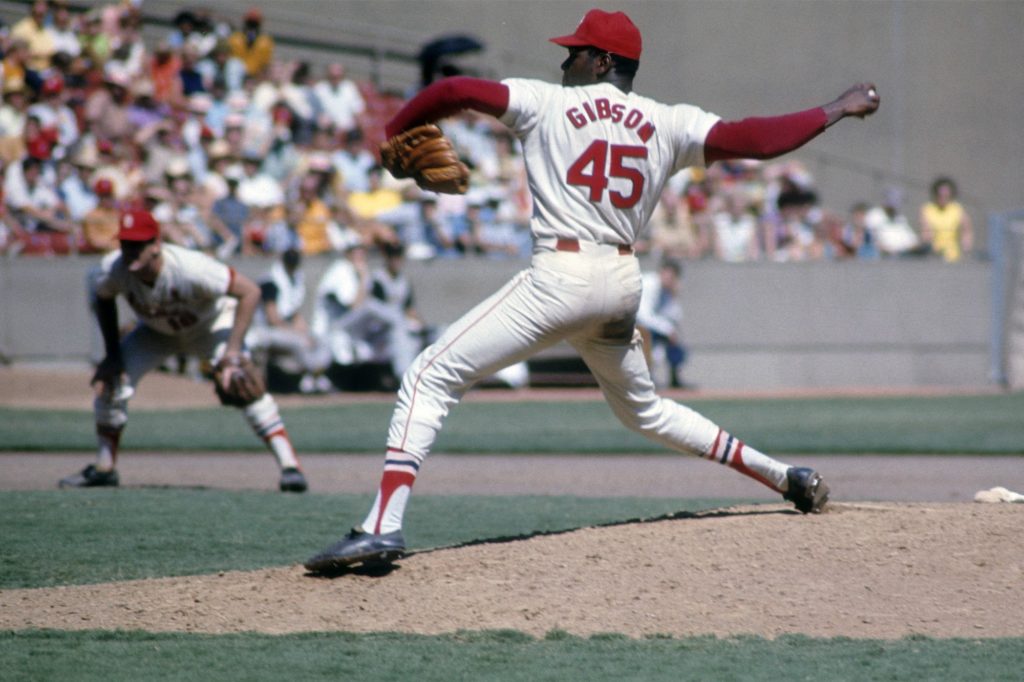On November 9th, 1935, a baseball icon was born.
And on November 9th, 2015, that same icon celebrated his 80th birthday.
Cardinals legend and Baseball Hall of Famer Bob Gibson turned 80 this past Monday.
For 17 seasons, all with the St. Louis Cardinals, Gibson, nicknamed “Gibby” and “Hoot” by his peers, struck fear into the hearts of every batter he faced, and cemented himself as one of the greatest pitchers of all-time. When he retired in 1975, Gibson finished with a record of 251-174 with a 2.91 ERA, 1.19 WHIP and 3,117 strikeouts in 3,884 1/3 innings. He was a two-time Cy Young Award winner, winning the Cy Young in 1968 and 1970 while also taking home the MVP in 1968.
Born in Omaha, Nebraska, Gibson was the youngest of seven siblings. However, his father died of tuberculosis three months before his birth. Throughout his childhood, he was onset by health issues, but was still a very involved athlete despite those issues. He eventually went to Creighton University, and after he majored in sociology, eventually joined the famed Harlem Globetrotters basketball team.
While with the Globetrotters, the St. Louis Cardinals also had interest in signing Gibson. Eventually in 1957, they signed him with a $3,000 bonus, but Gibson did not make his major league debut until April 15th, 1959, when he came out of the bullpen to pitch. On July 30th, by this time a starter, Gibson won his first ever start as a pitcher.
And thus the legendary career began.
His first three years weren’t too successful, compiling a 19-23 record, along with an ERA of 3.81. Within this time span, he also struck out 283 batters, and walking 206. In 1962, he received his first ever All-Star selection, and also struck out 200 batters in a season for the first time. During the 1963 season, Gibson started off by trying to recover from an ankle injury the year before. It was also during this season that Major League Baseball expanded the strike zone.
Gibson used this to his advantage.
He finished the year with an 18-9 record, but the Cardinals missed first place by six games, as it was also Stan Musial‘s final season as a player. But they made up for the shortcoming in 1964 by having one of their best seasons in history. While racial tensions were high across America, the Cardinals had no issues regarding the matter, and many players, guided by Gibson and teammate Bill White, stopped using racial slurs for good.
As the St. Louis Cardinals dominated their way to the World Series, Gibson became the anchor of the team, and began his rise to being one of the most intimidating players in the game. In the 1964 World Series against the New York Yankees, Gibson went 2-1 in a series that the Cardinals won in seven games, and he also was named MVP.
Over the next three seasons, Gibson was named to three All-Star teams, won one World Series (1967 against the Boston Red Sox), and compiled a regular season record of 54-31. His ERA throughout those seasons was 2.81 and he struck out 642 batters.
But without a doubt, his greatest season came in 1968. Considered to be one of the greatest seasons by a pitcher in history in a year dubbed “The Year of the Pitchers”, Gibson won 22 games, losing only nine, and his regular season record of a 1.12 ERA still stands in the “live-ball era”. In fact, the performance he had throughout the year was so historic, Major League Baseball moved the mound down because of it.
The St. Louis Cardinals and Detroit Tigers clashed in the 1968 World Series, and while it once again went to seven games, this time, the Tigers were the team that ended up on top. This would be the last World Series appearance for Gibson.
He continued to pitch until the 1975 season, when swelling in his knee became a hassle for the veteran Gibson (then 40 years old). In 1981, he was forever immortalized in baseball history when, on his first ballot, was inducted into the Baseball Hall of Fame with 84% of the votes. His #45 jersey was retired by the Cardinals in 1975. He was also an inaugural member of the Cardinals Hall of Fame in 2014.
What made Gibson famous wasn’t just his dominant pitching.
It was his dominant demeanor.
On the mound and at the plate, Gibson rarely smiled or showed any emotion, and just went out there did his job. It was a job he could do well, and would not be told otherwise. When Cardinals Hall of Famer Tim McCarver, a catcher for Gibson for most of his career, went to the pitcher’s mound for a conference, Gibson simply brushed him off, saying “The only thing you know about pitching is that it’s hard to hit.”
But Gibson has still been active even 40 years after his retirement. He shows up constantly to Cardinals events, is an adviser with the Cardinals’ organization, and will forever remain in the hearts of Cardinals fans (and baseball fans in general) everywhere.
(Photo Credit: thedailybeast.com)


